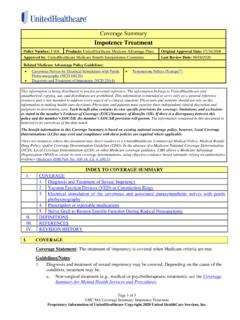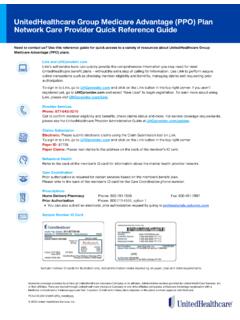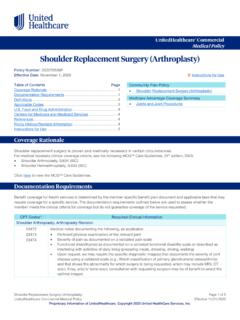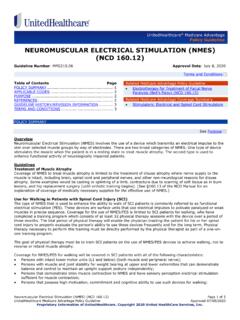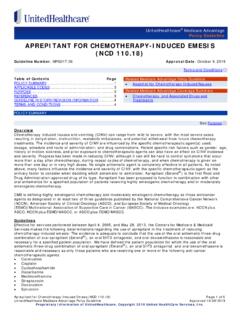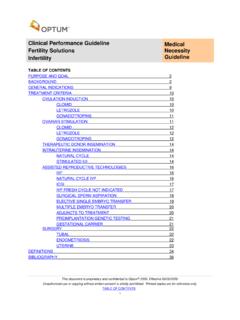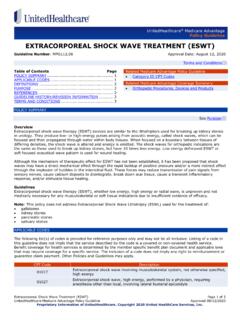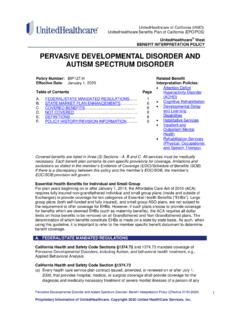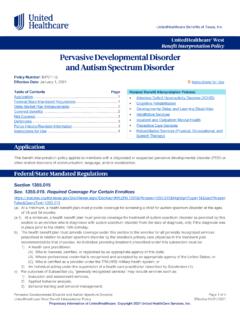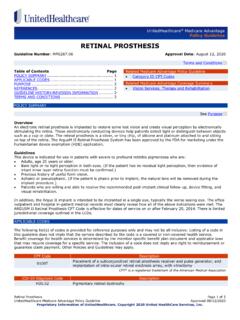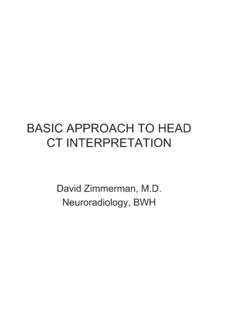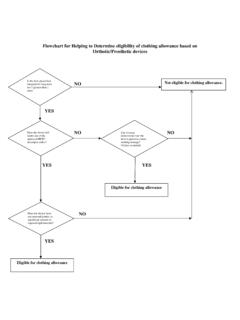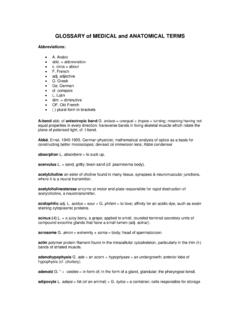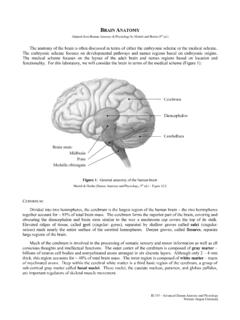Transcription of Oral Surgery: Orthodontic Related Procedures
1 Oral Surgery: Orthodontic Related Procedures Page 1 of 8 UnitedHealthcare Dental Clinical Policy Effective 01/01/2022 Proprietary Information of UnitedHealthcare. Copyright 2022 United HealthCare Services, Inc. UnitedHealthcare Dental Clinica l Policy Oral Surgery: Orthodontic Related Procedures Policy Number: Effective Date: January 1, 2022 Instructions for Use Table of Contents Page Coverage Rationale .. 1 Definitions .. 2 Applicable Codes .. 3 Description of Services .. 3 Clinical Evidence .. 4 Food and Drug Administration .. 7 References .. 7 Policy History/Revision Information .. 8 Instructions for Use .. 8 Coverage Rationale Surgical Placement of Temporary Anchorage Device (Not Related to Distraction Osteogenesis or Orthognathic Surgery) The surgical placement of temporary Anchorage devices are used in conjunction with Orthodontic treatment and are indicated for individuals aged 12 and over for the following: Intrusion of maxillary teeth Molar Distalization Canine Retraction and Intrusion Retraction mechanics Correction of anterior Open Bite and deep Overbite Correction of canted Occlusal Planes The surgical placement of a temporary Anchorage device is not indicated for individuals with any of the following.
2 Known allergy to titanium alloy History of heavy tobacco use Advanced osteoporosis Uncontrolled immune or metabolic bone disorders Unmanaged medical conditions that result in excessive bleeding, reduced resistance to infection, or poor healing response Poor oral hygiene Poor quality cortical bone density and volume Ankylosed teeth Surgical Access of Unerupted Tooth Surgical access of unerupted tooth is indicated for the following: When a normally developing permanent tooth is unable to erupt into a functional position For labially impacted teeth if there will be 2-3 mm of gingival cuff present after eruption Surgical access of unerupted tooth is not indicated for the following: For supernumerary teeth and third molars When surgical access of impacted tooth would threaten vital structures Related Dental Policy Medically Necessary Orthodontic Treatment Related Medical Policy Orthognathic (Jaw) Surgery Oral Surgery: Orthodontic Related Procedures Page 2 of 8 UnitedHealthcare Dental Clinical Policy Effective 01/01/2022 Proprietary Information of UnitedHealthcare.
3 Copyright 2022 United HealthCare Services, Inc. Individuals with unmanaged medical conditions that result in excessive bleeding, reduced resistance to infection, or poor healing response Placement of Device to Facilitate Eruption of Impacted Tooth This is the placement of an Orthodontic bracket, band or other device and attached with a chain, on an unerupted tooth, after surgical exposure, to aid in its eruption. This procedure is done following the surgical access of an unerupted tooth. Corticotomy (Not Related to Distraction Osteogenesis or Orthognathic Surgery) Corticotomy (also known as periodontally accelerated osteogenic orthodontics [PAOO] or surgically assisted osteogenic orthodontics [SAOO]) is unproven due to insufficient evidence of efficacy. Mobilization of Erupted or Malpositioned Tooth to Aid Eruption Mobilization of erupted or malpositioned tooth to aid eruption is indicated for the treatment of ankylosed permanent teeth.
4 Definitions Anchorage: Resistance to force. Anchorage may come from any of the following sources: intraoral (teeth, bone, soft tissue, implants), or extraoral (cervical, occipital, cranial) (AAO). Angle s Classification of Malocclusion: A classification of malocclusion introduced by Edward H. Angle. The governing criterion is the anteroposterior relationship of maxillary and mandibular first molars (AAO). Class I Malocclusion (Neutroclusion): A malocclusion in which the mesiobuccal cusp of the maxillary first molar occludes in the buccal groove of the mandibular first molar. Class I is sometimes incorrectly used as a synonym for normal occlusion, whereas it signifies only a normal sagittal relationship of maxillary and mandibular posterior teeth as they meet. Class II Malocclusion (Distoclusion): A distal (posterior) placement of the mandibular (lower) molar, a mesial (anterior) relationship of the maxillary (upper), or a combination of the two.
5 The mesiobuccal cusp of the maxillary first molar occludes mesial to the buccal groove of the mandibular first molar, usually near the embrasure between the mandibular molar and second premolar. o Division 1: A Class II molar relationship with proclined maxillary incisors. o Division 2: A Class II molar relationship, usually with the maxillary central incisors tipped lingually, the maxillary lateral incisors tipped labially. This malocclusion, in many instances, has and an excessive Overbite. o Subdivision: Subdivision of any malocclusion category denotes a unilateral malocclusion classification ( , Class II, division 2, subdivision). Class III Malocclusion (Mesioclusion): Mesial (anterior) relationship of the mandibular first molar to the maxillary first molar, a retruded relationship of the maxillary first molar to the mandibular, or a combination of the two.
6 The mesiobuccal cusp of the maxillary first molar will typically occlude near the embrasure between the mandibular first and second molars. Ankylosis: Abnormal immobility, union or fusion. It may occur between two bones at their articulation ( , TMJ) or between teeth and alveolar bone (AAO). Distalization: A common descriptor for the biomechanics involved in moving maxillary first and second molars distally and into a Class I molar relationship. Intrusion: A translational form of tooth movement directed apically and parallel to the long axis of a tooth (AAO). Occlusal Plane: The imaginary surface on which upper and lower teeth meet in occlusion. It is actually a compound curved surface, but is commonly approximated by a plane (straight line in the lateral view) based on specific reference points within the dental arches (AAO).
7 Open Bite: Lack of tooth contact in an occluding position (also called apertognathia) (AAO). Orthognathic Surgery: Orthognathic Surgery is the surgical correction of abnormalities of the mandible, maxilla, or both. The underlying abnormality may be present at birth or may become evident as the patient grows and develops or may be the result of traumatic injuries. The severity of these deformities precludes adequate treatment through dental treatment alone (AAOMS). Oral Surgery: Orthodontic Related Procedures Page 3 of 8 UnitedHealthcare Dental Clinical Policy Effective 01/01/2022 Proprietary Information of UnitedHealthcare. Copyright 2022 United HealthCare Services, Inc. Overbite: Vertical overlap of maxillary teeth over mandibular anterior teeth, usually measured perpendicular to the occlusal plane (AAO).
8 Retraction: Pertaining to desired posteriorly directed, Orthodontic or orthopedic displacements of teeth or of bones of the face (AAO). Applicable Codes The following list(s) of procedure and/or diagnosis codes is provided for reference purposes only and may not be all inclusive. Listing of a code in this policy does not imply that the service described by the code is a covered or non-covered health service. Benefit coverage for health services is determined by the member specific benefit plan document and applicable laws that may require coverage for a specific service. The inclusion of a code does not imply any right to reimbursement or guarantee claim payment. Other Policies and Guidelines may apply. CDT Code Description D7280 Exposure of an unerupted tooth D7282 Mobilization of erupted or malpositioned tooth to aid eruption D7283 Placement of device to facilitate eruption of impacted tooth D7292 Placement of temporary anchorage device (screw retained plate)requiring flap D7293 Placement of temporary anchorage device requiring flap D7294 Placement of temporary anchorage device without flap D7296 Corticotomy one to three teeth or tooth spaces, per quadrant D7297 Corticotomy four or more teeth or tooth spaces, per quadrant D7997 Appliance removal (not by dentist who placed appliance)
9 , includes removal of archbar D7298 Removal of temporary anchorage device [screw retained plate], requiring flap D7299 Removal of temporary anchorage device, requiring flap D7300 Removal of temporary anchorage device without flap CDT is a registered trademark of the American Dental Association CPT Code Description 41899 Unlisted procedure, dentoalveolar structures CPT is a registered trademark of the American Medical Association Description of Services Temporary anchorage devices (TADs) are used to improve anchorage during routine Orthodontic therapy. They are gaining popularity and can allow better anchorage than extraoral headgear which relies on significant patient compliance for success (TADs may also be used for distraction osteogenesis of the mandible and this use is medical in nature and typically covered under the member s medical plan).
10 Impacted teeth are those that are not expected to erupt into their normal position within the dental arch. The most common impactions occur with third molars and maxillary canine teeth but may involve any teeth. If impacted teeth (other than third molars, primary or supernumerary teeth) are exposed early and there is no tooth size or arch length discrepancies, these teeth will often erupt on their own. However, these teeth may require surgery to expose the tooth and place a bracket, band or other device on the unerupted tooth, after its exposure, to aid eruption. Corticotomy in this context is a relatively new surgical procedure that involves creating cuts in, or removal of alveolar bone for the purpose of accelerating Orthodontic treatment. Oral Surgery: Orthodontic Related Procedures Page 4 of 8 UnitedHealthcare Dental Clinical Policy Effective 01/01/2022 Proprietary Information of UnitedHealthcare.
